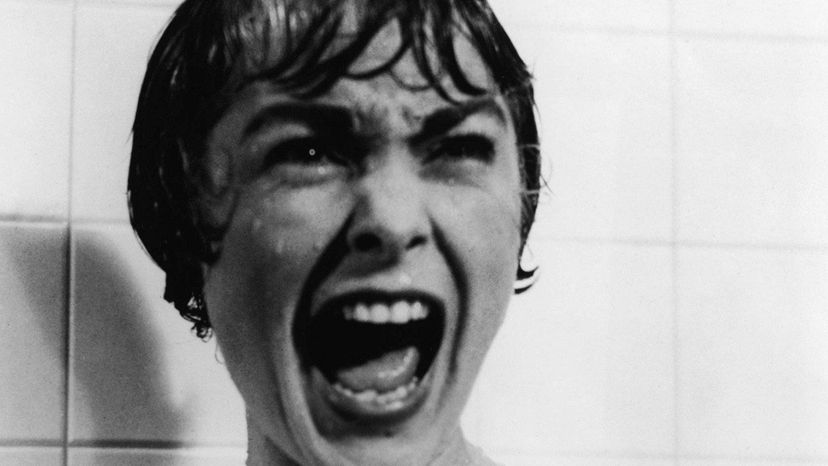
About This Quiz
We often refer to crazy people as "psychos," but this word more specifically refers to people who lack empathy. Enter the psychopathic character in Alfred Hitchcock's "Psycho," which plumbed the depths of a warped human mind capable of the worst kind of behavior. How much do you know about this masterpiece of horror filmmaking?"Psycho" was released in 1960. A (poorly received) remake directed by Gus Van Sant was released in 1998.
The movie's storyline comes from a novel of the same name written by Robert Bloch. Bloch wrote more than 30 novels during his lifetime.
Leigh was Marion Crane, a woman who decides to steal a pile of cash from her employer. She hits the road to escape and then winds up at a creepy little roadside motel.
Advertisement
Hitchcock had already been making films for decades before he made "Psycho." This film was a tremendously successful way for the famed director to cap off his stellar career.
Norman Bates, played by Anthony Perkins, has piercing eyes and stranger mannerisms. As it turns out, his social awkwardness disguises much deeper psychological problems.
Hopkins has been in some scary movies, but not "Psycho," which featured the likes of Anthony Perkins, Janet Leigh and John Gavin, among others.
Advertisement
A heavy rainstorm obscures the highway, and Marion is too tired to continue driving. She pulls into the Bates Motel parking lot, an act that seals her fate.
Some scenes are so famous that they become a part of our society's cultural consciousness. The famous shower scene is one of the most suspenseful moments in Hollywood history.
As Norman stalks Marion in the shower, the audience sees his knife-wielding silhouette on the shower curtain. Bates then proceeds to stab Marion to death.
Advertisement
Norman has psychological problems that allow him to commit heinous acts thinking that he's not responsible. He believes that "Mother" killed Marion and that he's been left to clean up the mess.
Consumed by jealousy, Norman killed both his mother and her boyfriend. Later, he digs up his mother's corpse and begins treating it as if his mother was still alive -- you know, pretty normal behavior for a middle-aged man.
Norman gathers all evidence of Marion's stay (along with her body) and stuffs it into her vehicle. Then he rolls the car into a nearby swamp in hopes of concealing the crime.
Advertisement
The edgy material didn't dissuade Hollywood from embracing this film. "Psycho" received four Oscar nominations.
"Psycho" was not nominated for Best Picture. It was nominated for Best Director, Best Supporting Actress, Best Cinematography, Black-and-White and Best Art Direction, Black-and-White.
As it turned out, the nominations didn't go anywhere. "Psycho" didn't win any Oscar awards.
Advertisement
The three-minute scene uses dozens of (often disorienting) camera angles meant to jar the audience. By the end of the scene, many viewers were probably scarred for life.
The investigator is hired by Marion's family and tasked with finding her. Instead, the man stumbles into a much creepier (and deadlier) situation.
The movie was shot on a set built in Hollywood. There's no actual Bates Motel -- it was constructed right on the property of Universal Studios.
Advertisement
Ed Gein was a particularly odd serial killer who committed his crimes in 1950s Wisconsin. He took to digging up bodies and use the parts to make various creations. Eventually, he murdered two women.
There were some notable changes as the book was adapted to the screenplay. The book was much more violent. And in the novel, Norman has a drinking problem -- in the movie, he's a sober but twisted individual.
Marion stole $40,000, which would be more than $320,000 in today's money. The small fortune triggers quick, violent karma.
Advertisement
Paramount refused to fund the movie due to its strange and violent content, meaning that Hitchcock had to support the budget with his own production organization. The limited budget pushed him into using cheaper black-and-white film.
Both Leigh and Hopkins were Hollywood stars when Hitchcock asked them to take part in the movie. Leigh was so enthused to work on the project that she agreed to do the job for a fraction of her usual salary.
The film received very mixed reviews from critics, but it resonated with audiences around the world. It made roughly $50 million at the box office and became Hitchcock's most profitable movie.
Advertisement
This was a low-budget venture, even for 1960 -- it was made for less than $1 million. It earned that amount back (and much more) in just a few days at theaters.
Norman turns out to be a fairly prolific murderer. He killed his mother and her boyfriend, Marion (and two other single women), as well as the private detective who comes along looking for Marion.
Hitchcock supposedly wanted his masterpiece film to be a complete surprise. He reportedly bought many copies of the book to preserve its surprise twists.
Advertisement
At this point of his career, Hitchcock was well-known for making brief appearances in his films. He opted to appear very briefly at the beginning of the movie so that audiences could spot him…and then turn their attention to the horrific story unfolding on the screen.
Leigh's role in the movie apparently had a deep effect on her mind. She was freaked out by showers and reportedly tried to avoid them once shooting was completed.
Hitchcock felt the movie's suspense was best absorbed in total from beginning to end -- no one was allowed into the theater once the movie started.
Advertisement